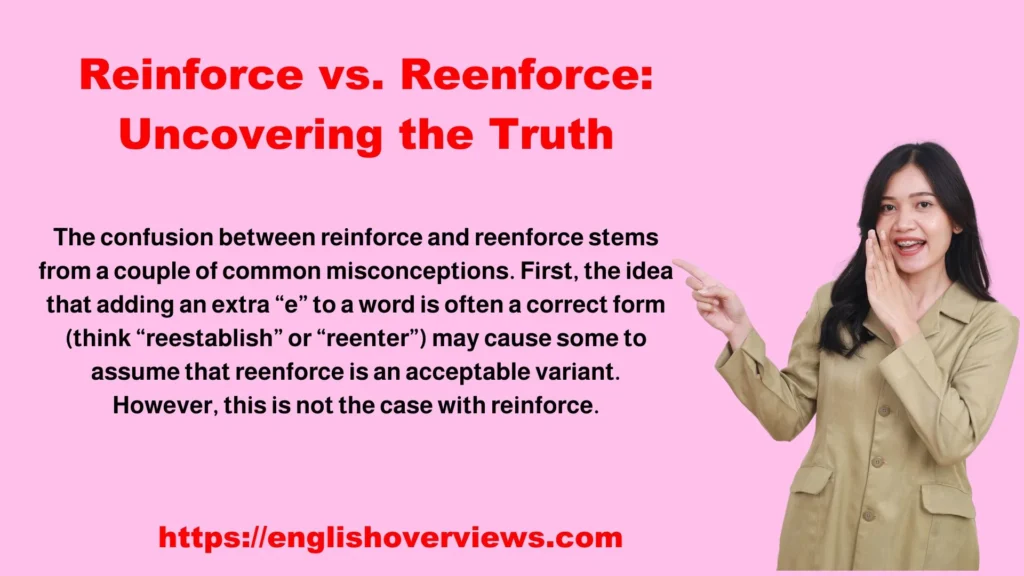In the world of writing, it’s easy to fall into the trap of small errors that may seem insignificant but can impact the overall quality of your work. One such issue many writers face, whether they’re novice bloggers, students, or seasoned professionals, is the confusion between two similar-sounding words: reinforce vs reenforce.
The correct spelling, of course, is reinforce. But despite this, reenforce is still used by some writers who either mistakenly believe it’s the correct form or who might confuse it with other similar words.
The truth, however, is that reenforce is not a valid English word. So, if you’re writing for any audience, whether it’s professional, academic, or casual, you want to avoid making the critical mistake of using the wrong form.
In this article, we’ll delve into everything you need to know to understand reinforce fully—its meaning, usage, grammatical forms, and more. By the end, you’ll be equipped with the tools to use this word correctly in any situation.
Reinforce vs. Reenforce: Uncovering the Truth

Why “Reenforce” Is Incorrect
The confusion between reinforce and reenforce stems from a couple of common misconceptions. First, the idea that adding an extra “e” to a word is often a correct form (think “reestablish” or “reenter”) may cause some to assume that reenforce is an acceptable variant. However, this is not the case with reinforce.
The word reinforce has been in use since the early 17th century and derives from the Latin word “reinforcare,” which means “to strengthen.” Over time, its meaning has remained consistent, referring to making something stronger or more durable.
There is no record of reenforce appearing in any reputable dictionaries, and you won’t find it in any formal English texts.
The Importance of Using “Reinforce” Correctly
The reality is that spelling errors like reenforce can make your writing look less polished, even if the rest of your work is solid. When you make a mistake like this, you risk losing credibility with your audience.
In professional writing, consistency and accuracy matter. Misusing words not only harms your writing’s clarity but also undermines your authority as a writer.
Since reenforce is a misspelling, using it could cause confusion among your readers, who may wonder if they’ve come across a new, non-standard word. In academic, corporate, or professional settings, that’s a risk you don’t want to take.
The Correct Spelling: Why “Reinforce” Is Always Right
What Does Reinforce Mean?
The meaning of reinforce is straightforward: it means to strengthen, support, or increase the effectiveness of something. It can be used both in a physical context, like when strengthening a structure, or in more abstract contexts, such as reinforcing an argument or a belief.
Physical Reinforcement:
- In construction, engineers may reinforce a building’s foundation by adding additional supports to ensure it can withstand heavy loads.
Psychological Reinforcement:
- In psychology, a teacher might reinforce positive behavior by offering praise or rewards. This encourages students to continue displaying that behavior.
Argument Reinforcement:
- When writing a research paper or giving a presentation, you may reinforce your point with data, statistics, or credible sources to make your argument more compelling.
Reinforce is an incredibly versatile word that can be applied in many situations where something is being made stronger, more effective, or more convincing.
Historical Origins of Reinforce
To understand the usage of reinforce, it’s helpful to look at its linguistic history. The word reinforce comes from the Latin word “reinforcare,” which literally means “to strengthen again.” Over time, it became a key term in English, used in military, architectural, and academic contexts.
In fact, reinforce is so commonly used in modern English that it has become part of everyday language. Whether you’re strengthening a physical structure, bolstering an idea, or improving team morale, the word fits a wide array of scenarios.
Definition of Reinforce vs. Reenforce: What’s the Difference?

Reinforce: The Correct and Only Option
As we’ve already discussed, reinforce is the right choice when you want to describe strengthening, supporting, or increasing the effectiveness of something. This word has several applications across different fields:
- In construction: Reinforcing a wall or roof by adding additional material to ensure safety.
- In education: Reinforcing a lesson by reviewing key points and providing practical exercises.
- In social contexts: Reinforcing a habit by offering encouragement and rewards.
The key takeaway here is that reinforce is the word you should use whenever you’re talking about making something stronger or more secure.
Reenforce: A Misspelling
The use of reenforce is a common mistake that arises because of the way some words are spelled with a doubled “e” (such as “reenter” or “reestablish”). However, there is no version of this rule that applies to reinforce. Reenforce simply doesn’t exist in the English language.
If you ever come across reenforce, it’s almost certainly a typo or a misheard version of reinforce. Always correct it to reinforce in your writing to ensure clarity and professionalism.
Verb Forms of Reinforce (and Why “Reenforce” Isn’t One)

Verb Forms of Reinforce
The verb reinforce is used in various tenses and conjugations, just like any other regular verb in English. Here are the primary verb forms of reinforce:
- Present: I reinforce, you reinforce, he/she reinforces.
- Past: I reinforced, you reinforced, he/she reinforced.
- Present participle/gerund: Reinforcing.
- Past participle: Reinforced.
Examples:
- Present: “The company reinforces its brand message through consistent advertising.”
- Past: “The teacher reinforced the lesson with a group activity.”
- Present participle: “They are reinforcing the bridge with additional steel supports.”
These verb forms are flexible and allow for reinforce to be used in a variety of contexts.
Why “Reenforce” Isn’t a Verb Form
Since reenforce is not a real word, it doesn’t have any valid verb forms. Therefore, you won’t see constructions like “reenforced” or “reenforcing” in proper English usage. Stick with reinforce and its conjugations to ensure correctness in your writing.
Noun Forms of Reinforce and the Right Approach
Reinforcement: The Noun Form of Reinforce
The noun form of reinforce is reinforcement. This term refers to the act of making something stronger, or the additional support given to something that already exists.
Examples of Reinforcement:
- “The reinforcement of the building’s walls with steel beams helped it withstand the earthquake.”
- “The coach’s reinforcement of the team’s tactics led to a winning strategy.”
- “The reinforcement of positive behavior in children is essential for their development.”
As you can see, reinforcement is commonly used in both physical and abstract contexts, from construction to psychology.
No Noun Form for “Reenforce”
Since reenforce is a misspelling, there’s no valid noun form associated with it. The correct noun form is always reinforcement. Avoid trying to create a noun form for reenforce as it simply doesn’t exist.
Real-World Examples of “Reinforce” in Action
To make sure you truly understand how to use reinforce, let’s look at some real-world examples in different contexts:
1. In Business:
- “To achieve long-term success, companies must reinforce their marketing efforts by consistently engaging with their audience.”
2. In Education:
- “By offering rewards for completing assignments, teachers reinforce positive learning habits.”
3. In Social Interactions:
- “Parents can reinforce good behavior by setting clear expectations and offering praise when those expectations are met.”
Reinforce vs. Reenforce: Grammar and Usage Pitfalls

Common Mistakes When Using Reinforce
Despite its clear definition and usage, people often misuse reinforce in different ways. Here are a few common mistakes to avoid:
- Mistake #1: Spelling reenforce instead of reinforce.
- Mistake #2: Using reinforce in the wrong context (e.g., using it where a word like support would be more appropriate).
- Mistake #3: Overusing reinforce in your writing without considering more varied synonyms.
Grammar Tips to Get It Right
- Spellcheck: Use a spell checker to catch instances of “reenforce” that may have slipped by.
- Context: Make sure reinforce is used in the correct context. If you’re talking about making something stronger, you’re likely on the right track.
How to Use Reinforce Properly
To help you avoid mistakes, here’s a quick checklist on how to use reinforce effectively:
Do’s:
- Use reinforce when talking about making something stronger or providing additional support.
- Use reinforce in both formal and informal settings (business, education, writing, etc.).
- Use reinforce in a variety of contexts (emotional, physical, abstract).
Don’ts:
- Don’t use reenforce under any circumstance.
- Don’t confuse reinforce with similar words like fortify or strengthen without considering the nuances.
Historical Usage of Reinforce and Why It’s Evolving
The Evolution of Reinforce
The word reinforce has been in the English language for centuries. It first appeared in its current form in the late Middle Ages. Over time, its meaning has remained relatively consistent, referring to the idea of making something stronger or more supportive.
Despite reenforce’s appearance in some modern speech, its historical absence in authoritative English dictionaries reinforces the argument that it’s a mistake.
Regional Differences: Does the Use of Reinforce Change Around the World?

Global Consistency in Usage
While regional dialects sometimes introduce variations in spelling and word choice, the correct use of reinforce is consistent across different forms of English (American, British, Australian, etc.).
No region uses reenforce as an acceptable form, and reinforce remains the universal standard. It’s important to understand this to avoid mistakes, especially when writing for a global audience.
Key Takeaways: Avoid the Critical Mistake
- Reinforce is the correct word. Reenforce doesn’t exist in English.
- Always use reinforce in your writing, whether you’re strengthening an argument or a physical structure.
- Pay attention to spelling and context to avoid errors that can diminish your writing’s clarity and credibility.
FAQs: Answering Your Last-Minute Questions
1. What’s the difference between “reinforce” and “fortify”?
- Reinforce generally means to add support or strength to something. Fortify can also mean to strengthen, but it often implies defense against an attack (e.g., fortifying a castle).
2. Why do people keep spelling it “reenforce”?
- The misspelling likely comes from confusion with the prefix “re-,” which often suggests repetition, or due to mishearing the word in casual speech.
3. Can “reenforce” be used in any context?
- No, reenforce is not a valid word in the English language and should never be used.
Conclusion: Boost Your Writing Skills with Confidence
Now that we’ve covered the ins and outs of reinforce vs. reenforce, you can confidently move forward, knowing that reinforce is the only correct form. Remember, small spelling errors can make a big impact on your credibility, so always double-check your writing for accuracy.
By mastering these subtle details, you’ll improve your overall writing and communication skills. So, next time you’re faced with this decision, you’ll know exactly which word to choose!

English Overviews is a resourceful website dedicated to providing valuable content related to grammar and vocabulary. Muhammad Haroon has made notable contributions, sharing insights on various subjects, including WordPress themes and plugins. The primary goal of the site is to help users improve their English language skills effectively.











